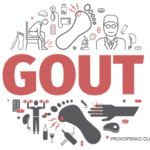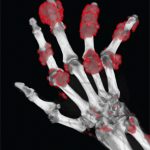Discussing the newly presented findings from 12 months, Dr. Botson noted that no patient had had an infusion reaction after week 24. “You can see that the patients continued to respond,” he said. “You still have a delta of around 30%. We have about a doubling of the efficacy” (60.0% in the methotrexate co-therapy group vs. 30.8% in the placebo co-therapy group).3
Immunogenicity findings were also similar to those found at six months, indicating a lower rate of new anti-PEG antibodies in the group on methotrexate co-therapy. Grouped together, patients who did not develop anti-PEG antibodies had a better response rate and lower rate of infusion reactions than those who did. However, of those patients who did develop anti-PEG antibodies, patients on methotrexate had a better treatment response and lower rate of infusion reactions (six-month response rate 54.5% in methotrexate group vs. 25.0% in placebo); in those who did not develop such antibodies, patients on methotrexate also had a higher response rate and lower risk of infusion reaction (six-month response rate of 80.8% vs. 58.3%).1-3
Dr. Botson also shared a secondary end point in patients with gout tophi at study onset. At six months, 34.6% of those in the methotrexate-treated group had resolved at least one tophus, compared to 13.8% in the placebo group. By 12 months, 53.8% had resolved at least one tophus in the methotrexate group, with a greater than 20% improvement over patients receiving placebo co-therapy (31.0%).3
Dr. Botson noted the field has become more interested in other potential options for immunomodulation since their study was initially designed, such as mycophenolate mofetil or azathioprine.4 The researchers picked methotrexate partly because of rheumatologists’ comfort level with the drug, and they chose a moderate dose of 15 mg that most patients could tolerate, but that they hoped would provide better long-term response to pegloticase than a lower dose.
When asked how long he recommended continuing treating patients on pegloticase, Dr. Botson replied, “Have a goal in mind, whether that’s symptom relief, having no gout flares or resolution of tophi. We have data out to 52 weeks, and we show improvement … from six months to 12 months. In my mind, as long as the patient is responding and their serum uric acid is staying down and they are not having flares, you can continue until you reach that end point.”



